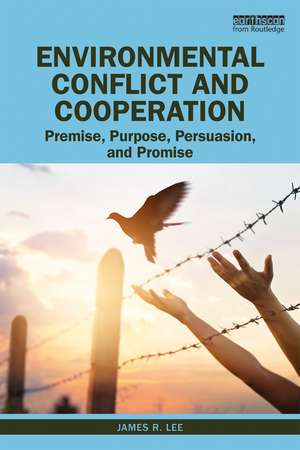Environmental Conflict and Cooperation: Premise, Purpose, Persuasion, and Promise
Autor James Leeen Limba Engleză Paperback – 25 iun 2019
Over four key parts, James R. Lee navigates the contours of this growing field and paints a vivid framework for better understanding issues around environmental conflict and security:
• The premise of the field and its historic manifestations
• The definition and purpose of research
• The persuasions or types of environmental conflict and cooperation
• The promise of research in leading to better decision-making and to broaching new challenges.
Over the course of these parts, the author outlines the deep historic record of this discipline, arguing that it will play a key role in understanding important future trends. Utilizing a wide variety of case studies that range from ancient examples, including conflict over the Cedars of Lebanon and the role of tin in the Peloponnesian Wars, to future-oriented scenarios, including expanded island-building in the South China Sea and the global politics of geo-engineering, Lee highlights key concepts, metrics, and policy contexts that will test current understandings. He also examines a variety of research methods and provides examples of the ways in which such research can be used to inform policy improvements.
This book will draw specific interest from students and scholars of environmental conflict and cooperation, as well as researchers of environmental politics and security studies.
| Toate formatele și edițiile | Preț | Express |
|---|---|---|
| Paperback (1) | 411.98 lei 6-8 săpt. | |
| Taylor & Francis – 25 iun 2019 | 411.98 lei 6-8 săpt. | |
| Hardback (1) | 1000.27 lei 6-8 săpt. | |
| Taylor & Francis – 25 iun 2019 | 1000.27 lei 6-8 săpt. |
Preț: 411.98 lei
Nou
Puncte Express: 618
Preț estimativ în valută:
78.86€ • 85.69$ • 66.28£
78.86€ • 85.69$ • 66.28£
Carte tipărită la comandă
Livrare economică 21 aprilie-05 mai
Preluare comenzi: 021 569.72.76
Specificații
ISBN-13: 9780815352518
ISBN-10: 0815352514
Pagini: 248
Ilustrații: 47 Tables, black and white; 27 Line drawings, black and white; 27 Illustrations, black and white
Dimensiuni: 156 x 234 x 13 mm
Greutate: 0.35 kg
Ediția:1
Editura: Taylor & Francis
Colecția Routledge
Locul publicării:Oxford, United Kingdom
ISBN-10: 0815352514
Pagini: 248
Ilustrații: 47 Tables, black and white; 27 Line drawings, black and white; 27 Illustrations, black and white
Dimensiuni: 156 x 234 x 13 mm
Greutate: 0.35 kg
Ediția:1
Editura: Taylor & Francis
Colecția Routledge
Locul publicării:Oxford, United Kingdom
Public țintă
Postgraduate and UndergraduateCuprins
Part I
The premise of environmental conflict
1 The ancient roots of environmental conflict
2 An environmental conflict story
3 Why a book on environmental conflict?
Part II
The purpose of environmental conflict
4 Defining environmental conflict
5 The dimensions of environmental conflict
6 Stages of environmental conflict research
7 What is a field and why does it grow? Is there a field
of environmental conflict?
PART III
Persuasions of environmental conflict
8 Ten agreed upon assumptions
9 Pictures of the field
10 Types of cases
11 Visualizing the field through dimensional plots
PART IV
The promise of environmental conflict
12 Where do we go from here?
13 Using scenarios for problem solving
14 Future cases of environmental conflict and cooperation
15 Will the future surprise us?
Appendix A: ICE coding categories
Appendix B: Ranked data points used in plots
Index
The premise of environmental conflict
1 The ancient roots of environmental conflict
2 An environmental conflict story
3 Why a book on environmental conflict?
Part II
The purpose of environmental conflict
4 Defining environmental conflict
5 The dimensions of environmental conflict
6 Stages of environmental conflict research
7 What is a field and why does it grow? Is there a field
of environmental conflict?
PART III
Persuasions of environmental conflict
8 Ten agreed upon assumptions
9 Pictures of the field
10 Types of cases
11 Visualizing the field through dimensional plots
PART IV
The promise of environmental conflict
12 Where do we go from here?
13 Using scenarios for problem solving
14 Future cases of environmental conflict and cooperation
15 Will the future surprise us?
Appendix A: ICE coding categories
Appendix B: Ranked data points used in plots
Index
Notă biografică
James R. Lee is a Researcher in Residence, School of International Service, American University, Washington, DC, USA.
Recenzii
"This book is a first and authoritative attempt to lay out a top-down view describing the field of environmental conflict and cooperation. It also makes the strong case that such a field exists and will become much more important. It is a fantastic companion reader to the bottom-up work I edited, the Routledge Handbook of Environmental Conflict and Peacebuilding." –Ashok Swain, Department of Peace and Conflict Research, Uppsala University, Sweden
Descriere
Drawing on a wide range of case studies that are clearly highlighted and analysed over the course of the chapters, this book will be of great interest to students and scholars of environmental conflict and peacebuilding, environmental politics and security studies more broadly.
